How to Build a Beauty eCommerce Store from Scratch

The beauty business is not only growing but also evolving.
With a CAGR of 6.03%, the worldwide cosmetics market is expected to reach $474 billion by 2030 from a remarkable $296.83 billion. These figures clearly show the great possibilities in the beauty sector, which is just waiting for business people like you.
However, starting an online beauty store isn’t as easy as we anticipate. You may face several difficulties and factors to weigh along the journey. But relax; this article will help you in that regard.
In this article, we’ll cover everything from product selection to website setup, marketing, and more. So, are you ready to start building a profitable beauty online store? Let’s get started!
How to Build a Beauty eCommerce Store? — A Step-by-step Guide!
Starting an online beauty eCommerce store is a wonderful experience, but it takes meticulous planning.
This section will take you through each stage of starting a successful beauty eCommerce business. By the end, you’ll know how to bring your idea to reality.
Step #1 — Determine Your Beauty Niche
The first and most important step is to identify your beauty specialty. The beauty sector is wide and includes several sub-categories, therefore, it’s critical to narrow it down depending on your preferences, specialty, and market needs.
Here’s an idea of the most popular sub-niches in the beauty industry to help you pick:
While these are some of the most popular sub-niches, remember that the beauty business is constantly changing. You might even find a unique combination of these niches or discover an ignored area within the market.
| Sub-Categories Under Beauty Niche | |
| Skincare | Includes cleansers, moisturizers, serums, sunscreens, masks, and more. |
| Makeup | Covers all things makeup, from foundations and concealers to eyeshadow palettes, lipsticks, mascaras, and makeup brushes. |
| Haircare | Shampoos, conditioners, styling products (hair gels, mousses, sprays), hair color products, hair loss solutions, and hair accessories all fall under this sub-niche. |
| Bath & Body | This includes body washes, lotions, bath bombs, soaps, and other products for cleansing and pampering the body. |
| Fragrance | Perfumes, colognes, body mists, and essential oils |
| Men’s Grooming | A growing category with products specifically formulated for men’s skin, hair, and shaving needs. |
| Natural & Organic Beauty | Products made with natural and organic ingredients are increasingly popular, appealing to eco-conscious consumers. |
| Beauty Tools & Devices | Includes electronic facial cleansing brushes, micro-needling tools, light therapy devices, and tools like facial rollers, gua shas, and more. |
| Nail Care | Nail polishes, treatments, and nail art supplies. |
When choosing your topic, consider the following factors:
- Your special interest and skills
- Market demand and trends
- Competition in the space Potential for income and growth
- Your target audience’s wants and desires
Take your time with this choice. Research carefully, analyze market trends, and perhaps even test the waters with a small selection of goods before fully committing to an area.
Once you’ve decided on a niche that works perfectly for you, it’s time to move forward and decide on your product supplies. But before we dive into that, remember that your chosen area will influence many of your future choices, from product selection to marketing strategies.
So, choose carefully and passionately as your excitement for your chosen niche will be a moving force in your eCommerce journey.
Step #2 — Figure Out Your Product Supplies

Now that you’ve decided on a specific beauty niche, it’s time to determine how you’ll find product supplies. Regardless of your sub-niche, you have two major choices for getting beauty products to sell — (1) Manufacturing from scratch (2) Private labeling on existing products.
Let’s explore both choices in detail to help you make an informed decision.
1. Manufacturing Beauty Products

Manufacturing beauty products means building your formulas from scratch. This involves developing unique recipes, finding materials, handling production, packing, and testing your goods before selling them.
Here’s how the manufacturing process of beauty products would look like:
- Create a unique product formula.
- Source high-quality ingredients.
- Set up a small lab.
- Source packaging materials.
- Manufacture the product.
- Test your product for safety.
- Work on product packaging.
And there you have your products. Now, let’s check any benefits or drawbacks coming up when you choose to manufacture your beauty products on your own.
Pros and Cons:
Here are the pros and cons of manufacturing your beauty products.
| Pros | Cons |
| Control over ingredients and quality | Higher initial investment |
| Ability to create unique and exclusive products | Longer time to market |
| Flexibility in product development and customization | More regulatory hurdles to overcome |
| Potentially higher profit margins | Requires extensive knowledge of cosmetic chemistry |
| Easier to build a distinctive brand |
2. Private Labeling Existing Products
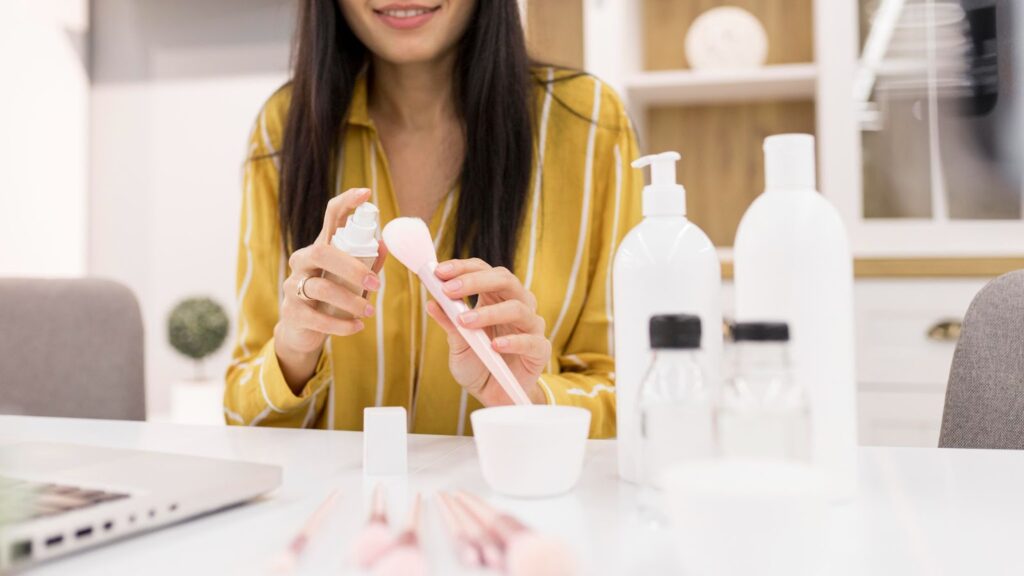
Private labeling includes choosing pre-made cosmetic formulas from manufacturers and labeling them as your own. This is where you modify the package and sell the goods under your brand name.
Here’s how the process of private labeling beauty products would look like:
- Do your research and find a reputable manufacturer.
- Choose from existing formulas or ask them to prepare a custom formula.
- Choose from various containers.
- Share details for custom labeling (including your logo, product information, and design elements).
- Place your order.
Also, if you’re worried about finding a private-label manufacturer, you can easily find them by attending beauty industry trade shows, on online platforms like alibaba, networking with other beauty brand owners, or through Google search.
Let’s also understand the benefits and drawbacks of choosing this method.
Pros and Cons:
Here are the pros and cons of choosing private labeling existing products:
| Pros | Cons |
| Lower initial investment | Less control over product formulation |
| Faster time to market | Potentially lower profit margins |
| Benefit from the manufacturer’s expertise | Limited uniqueness in the market |
| Easier to scale production | Possible minimum order quantities |
| Less regulatory burden |
Once you figure out how to manage your product supplies, it’s time to move to the next crucial step.
Step #3 — Choose a Business Name & Register a Trademark

Creating your beauty eCommerce store starts with choosing a business name. It defines your brand’s ethos and differentiates you in a saturated market. Here is the correct approach that you can follow.
1. Select a Store Name
It’s time you choose a name for your store.
The first thing your potential customers will know about your business is its name; hence, it should be impactful. Here, I’ve written some pointers that help you in choosing the right name for your beauty store.
- Make it Memorable and Original – Choose a name that is strong yet easy to spell, speak, and remember. Such a name will stick in customers’ minds, making it easy for them to remember each time they think about beauty products.
- Brand Alignment – Also, make sure that your chosen brand name aligns with your brand’s attitude, style, and target market. For example, a luxury skincare line would use a sophisticated name, but a fun, young makeup business might choose something more creative.
- Availability – Another important thing is to choose a unique name. So, check its availability on several platforms before you decide on it. Here are a few we can suggest.
- Local business registry in your state
- Database on trademarks
- Domain name
- Social media handles
Remember that your company name is a long-term commitment; thus, choose the one that reflects your brand perfectly.
2. Register trademarks
Trademark registration is about officially claiming your business name.
Once you register a trademark, your business name stays unique in the market and no other business can use it. In short, this stops other companies from copying your name and confusing customers.
So, once you select your business name, it’s time to get ahead for trademark registration. The quicker you proceed, the better chances you get to register for your chosen name. Or else, there could be a scenario where your desired name is being taken by another business, forcing you to start the naming process anew.
Moreover, you might be confused about the steps to register a trademark, we are discussing that right below.
3. Buy Domain Name
A domain name is the online address of your business. Here I’ve attached an image to share an understanding of what exactly a domain name is.
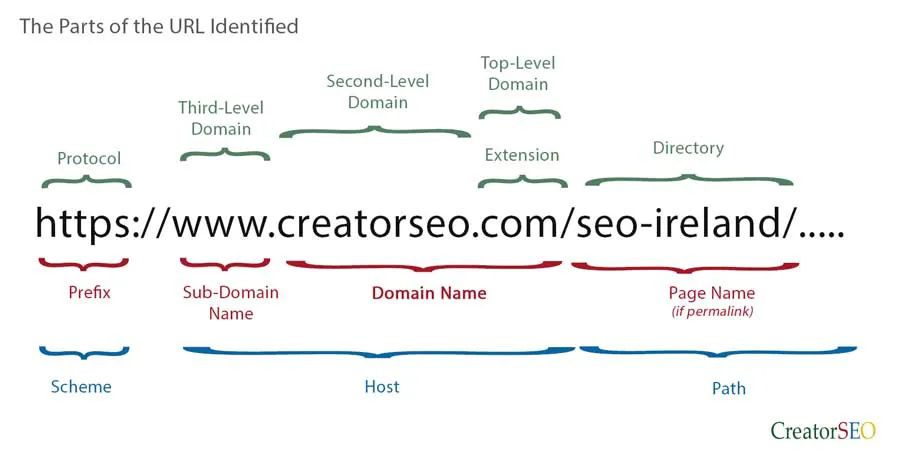
Source:- CreatorSeo.com
And it’s time you register your desired domain name promptly before someone else registers for it.
Some of the popular domain registrars include GoDaddy, Namecheap, BlueHost, and Google Domains. These platforms offer a range of domain extensions such as .com, .net, .org, and country-specific options to help select an appropriate domain extension that aligns with your target market and brand identity.
For more information, check our thorough article for more specific advice on selecting the appropriate domain name for your eCommerce store: Choose an eCommerce Domain Name.
Remember that your business name, trademark, and domain name are the basic components of your brand identification. Spend some time getting them just right. The success of your beauty eCommerce shop will depend heavily on them.
Step #4 — Choose an eCommerce Platform
Now that you’ve got your business name and trademark in order, it’s time to pick your eCommerce platform.
The foundation of your online beauty store will be your chosen platform, influencing scalability, design capabilities, user experience, and many more aspects. You’ll find multiple eCommerce platforms to get you started, each suited to varied demands, business size, budget, and more for you to pick from.
Here I’ve gathered information on top eCommerce platforms that will help create beauty stores. Let’s indulge ourselves in this table of information and get started with choosing one for you.
| Aspect | Shopify | Magento | WooCommerce (WordPress) | BigCommerce | Squarespace | Wix |
| Pricing (monthly) | Starts at $29 | Free (with paid third-party hosting) | Free (with paid WordPress hosting) | Starts at $80 | Starts at $26 | Starts at $18 |
| Ease of Use | Very Easy | Little Difficult | Moderate (requires WordPress knowledge) | Easy | Easy | Very Easy |
| Target Audience | Beginners, Small & Medium Businesses | Small to Large Businesses | Small & Medium Businesses | Medium Businesses | Small & Medium Businesses | Beginners, Small & Medium Businesses |
| Built-in Marketing Tools | Yes | Yes | Requires Plugins | Yes | Yes | Yes |
| Scalability | Highly Scalable | Highly Scalable | Scalable with Plugins | Highly Scalable | Moderately Scalable | Moderately Scalable |
| App Marketplace | Large App Store | Large App Store | Large Plugin Marketplace | Large App Store | Moderate App Store | Moderate App Store |
| Design Flexibility | Good | Excellent | High (with coding knowledge) | Good | Good | Good |
I know that having all the information is just not enough, and you still need help in choosing the right platform. Below I’ve added tips to help you with the same.
Choosing the Right eCommerce Platform for Your Beauty Business
Here, we’ll discuss areas that you can consider while selecting an eCommerce platform for your beauty store.
- Ease of use — Look for a platform that is easy to use as you’ll need to work on it each day and it should be effortless. Platforms like Shopify, Squarespace, and Wix provide easy-to-use layouts and set-up systems.
- Design Flexibility — Beauty companies usually call for visually appealing storefronts. If you know coding or have the budget to invest in developers, platforms like WooCommerce, Shopify, Magento, and BigCommerce are highly flexible to design appealing storefronts.
- Built-in Marketing Tools — Platforms such as Magento, Shopify, Wix, and BigCommerce come with built-in SEO capabilities, email marketing integrations, and social media features that allow easy management for your marketing campaigns.
- Budget — The expenses will be your big consideration. So choose your platform based on its price tag and your resources.
For more comprehensive guidance on selecting the finest eCommerce platform for your small beauty online business, we suggest reading this article: Best eCommerce Platform for Small Businesses.
Moreover, consider taking advantage of free trials offered by various platforms to gain hands-on experience with their features and interfaces. Remember that the correct platform will support future expansion and the best shopping experience for store visitors, thereby helping to create a strong online presence for your beauty store.
Step #5 — Get Your Branding Done

After selecting your eCommerce platform, the next crucial step is to start branding your online store. Here’s how you can do it:
Starting a profitable beauty brand depends on branding. It distinguishes your products from others and enables customers to relate emotionally. Let’s examine the two most important components of branding — (1) designing a logo (2) and drafting your “About Us” page.
1. Create a Logo
Your logo is the first thing that your target audience will recognize your brand with. The logo is a prominent and memorable element, so yes, you’ll need to design it uniquely and in a way that communicates most about your beauty brand.
Here’s an idea on how you can create a better logo design:
- Choose a simple, recognizable logo
- Align the logo with your brand’s look
- Ensure it works across all platforms
- Use colors that resonate with your audience
- Select fonts that reflect your brand’s style
Once your logo is ready, the next step is to craft a compelling copy for your About Us page.
2. Write a Copy For About Us Page
Your “About Us” page connects with your audience and tells your brand’s story. It’s your only chance to highlight the values and personality of your brand. Here are a few considerations for building a better About Us page.
- Share your company’s origins, goals, and USP.
- Highlight your commitment to values like sustainability.
- Use a style that reflects your brand’s personality.
- Show how your products enhance customers’ lives.
- Ensure the copy is error-free.
- Add images of your team or behind-the-scenes.
- End with a clear next step for readers.
To make a strong impression on your target audience, create a memorable logo and a great “About Us” page. These will help your brand connect with customers and stand out.
Keep in mind that branding is an ongoing process. As your beauty business grows and changes, you may need to revisit and improve these elements. The secret of success is to be authentic to your basic principles while changing to satisfy their changing demands.
Your visual identity and brand story are now in place so let’s move to the next step.
Step #6 — Figure Out Your Expectations For an Ideal Beauty Website
This stage is important since it follows the development process and guarantees that your website satisfies the needs of your customers.
Here, all you have to do is build a solid plan that communicates effectively with your website developers and ensure the final product aligns with your goals. This process will include the features you need on your beauty store, your design preferences, needed web pages & elements, your budget, and more.
Let’s discuss them all piece by piece.
1. Features for Your Beauty Website
The first thing you do is make a list of features that you’ll need in your beauty store. To help you with this, below, I’ve added some of the best features you can have in your beauty store.
Best Online Beauty Store Features:
- Product Filtering and Search
- Product Reviews and Ratings
- Virtual Try-On
- Ingredient Lists and Product Information
- Shade Finder
- Wishlist or Favorites
- Product Recommendations
- Live Chat or Chatbot
- Loyalty Program
- Blog or Educational Content
These are just a few of the best ones. You can do your research and list the ones that may fit your business the best.
2. Design Style and Aesthetics
Next, when setting up your beauty website, focus on design elements that make it visually appealing and aligned with your brand. Here’s what to consider:
- Choose colors that reflect your brand and create the right atmosphere (e.g., light pastels for a natural beauty brand, bold colors for a lively makeup line).
- Pick readable fonts that match your brand’s personality.
- Use high-quality images and visuals to make your site stand out.
- Opt for a simple, intuitive layout that directs visitors to key areas.
- Ensure your website looks great on all devices, especially mobiles.
These design tips will help ensure your website captures your brand’s essence and engages your audience effectively.
3. Must-Have Pages and Elements
Next up, you need to figure out the web pages you’ll need on your beauty store. In general, for your beauty website, it is recommended to include these pages:
- Home Page
- Product Category Pages
- Individual Product Pages (IPPs)
- About Us Page
- Contact Page
- FAQ Page
- Shipping and Returns Page
- Privacy Policy and Terms of Service
- Cart and Checkout Pages
These pages and elements will help create a comprehensive and user-friendly beauty website. For more details, check out our article on eCommerce website pages.
4. Budget Considerations
Figuring out how much money you can spend to develop a website is really important.
This will decide on the kind of website you can make, like if you can have custom elements or if it needs to be simple. Also, consider all the resources you have and the budget you can allocate to development, while also planning for the ongoing expenses needed to maintain the website after it’s launched.
Make sure to take your time and figure out your needs and budget to build a website that is easy and fun for your customers to shop at.
Now that you have the perfect picture of your beauty website and are fully prepared to get the most out of the development stages, let’s put your beauty eCommerce idea into practice.
Step #7 — It’s Time to Design & Develop Your Beauty Website
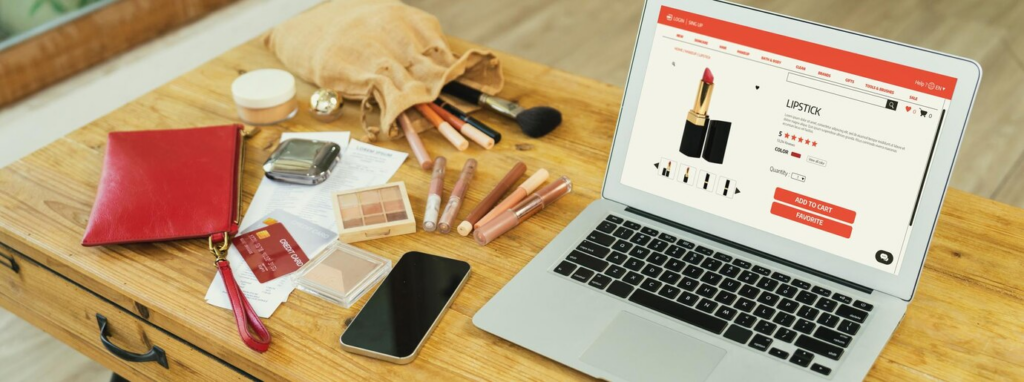
With a clear understanding of your ideal beauty website, the next crucial step is to find the right team to transform your vision into a reality. This involves selecting skilled professionals who can seamlessly work around aesthetics, functionality, and user experience to build a cohesive online store.
And there are multiple places and ways to find talented developers and designers. However, to make your journey easier, I’ve suggested a few here.
Where to Find Design & Development Agencies/Freelancers
- Freelance platforms such as Upwork, Fiverr, and more such platforms
- Google search
- Recommendations from friends/family/beauty businesses
When you choose to hire an agency or freelancer, make sure to check their portfolio, testimonials from previous customers, experience level, pricing, timeline, and more that help hire a reliable development partner.
eCommerce developers at Aureate Labs are well-versed in building beauty stores with a variety of platforms that you may choose to proceed with. Our team of experts can help you create a stunning and functional online beauty store that resonates with your target audience.
Here are more details on our eCommerce services for you to look around.
Also, when you successfully hire a candidate to work on your online beauty store development, make sure to share all the details that we gathered in Step:6. When they are given the right information on what you need for your website, they’ll be able to provide you with a better budget, timeline, and a greater website overall.
Step #8 — Start Listing Your Products
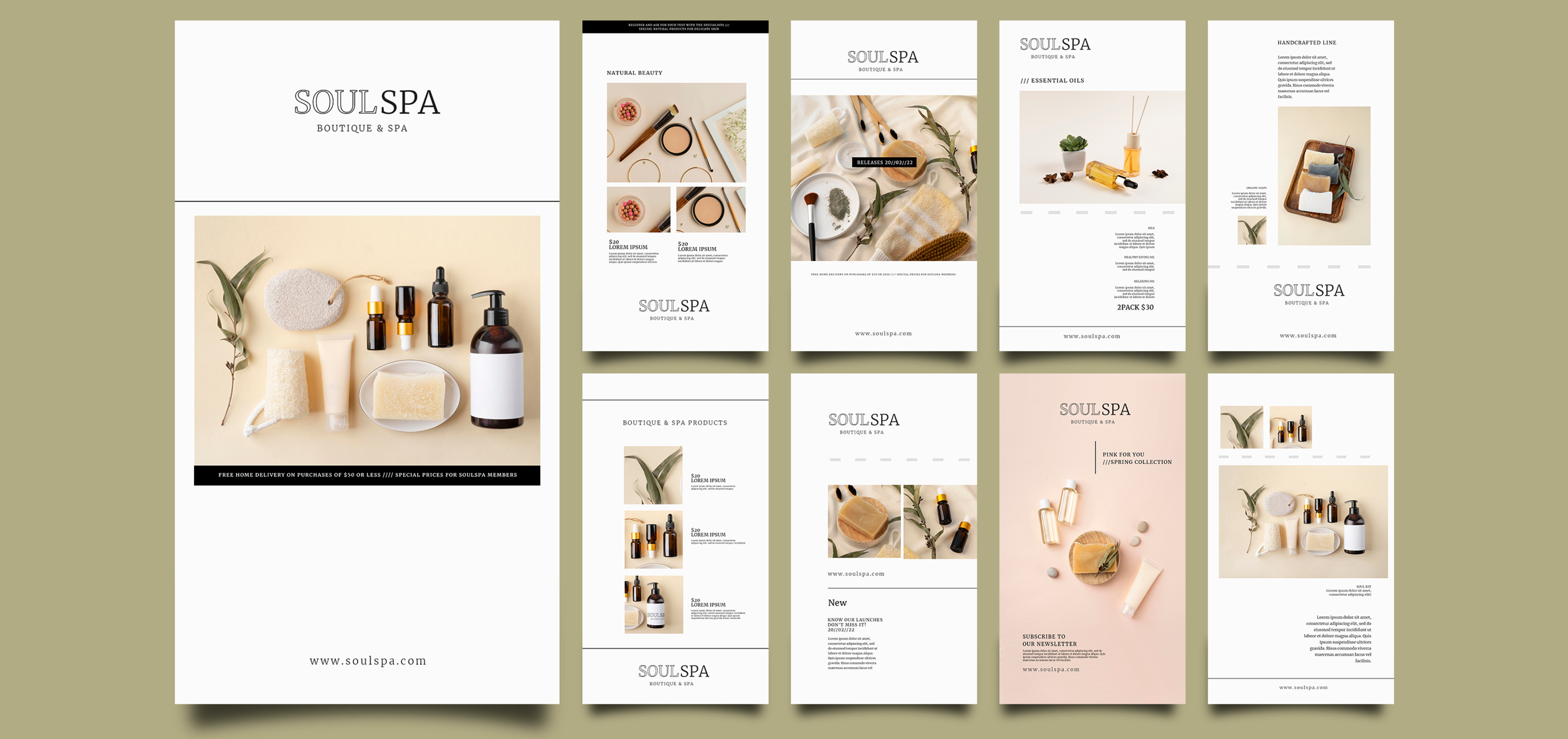
At this point, you’ll have your beauty store developed entirely. So the next big step is product listing.
This is a crucial step, as how you present your products can greatly influence the customer experience and, ultimately, your sales in the future.
You can start by making a list of your products and all the necessary details in an Excel sheet or document to upload it all efficiently. When you start listing products and work on product detailing, pay close attention to each aspect such as;
- The product name, description, and imagery should work together to tell a cohesive story.
- Your descriptions should be engaging and informative
- Highlight the unique selling points and benefits of each product
- Mention if the product is vegan or cruelty-free
- Does it have standout ingredients that set it apart from the competition?
- Make sure to divide them into the right categories
These are all important details that can sway a purchasing decision, so make sure you highlight them well within your product information. This organization will not only make it easier for customers to find what they’re looking for.
Step #9 — Start Optimizing Your Beauty Website for Search Engines
By this time, you’ll have a website that is filled with products and all the necessary details that make it shopping-ready.
And it’s time you prep it for SEO. Making sure that your beauty eCommerce site is search engine optimized will be a way to bring more visitors and increase conversion rates. Here are the basic SEO activities you can perform:
- Keyword Research — Different tools, such as Google Keyword Planner, SEMrush, and Ahrefs, are available when conducting keyword research.
- High-Quality Content — Blog posts, how-to guides, and product descriptions are good ways of inserting keywords.
- On-Site SEO — Includes insertion of keywords in the header section, meta descriptions, titles, and images. Also, make sure your website is mobile-friendly and includes alt text for images.
- Website Structure — Clear navigation and a clean design make it easier for search engines and users to find what they want.
These SEO techniques will help you create a website that Google will love and customers will be able to find quickly.
Have an idea of what’s next? In the next part, we’ll create the fundamental policies any eCommerce store must create in confidence and safeguard its company.
Step #10 — Create Policy Pages
Policy pages are a must-have for every eCommerce store to create customer trust and protect your business. These pages are crucial for laying the ground rules and ensuring smooth transactions. Here are the main policy pages you should consider:
- Return Policy
- Shipping Policy
- Refund Policy
- Privacy Policy
- Terms & Conditions
- FAQ page
So, now is the time to start writing copy for these pages. Make sure to include each policy and detail specific to these pages in clear and concise language that is easy for your customers to understand.
And that’s all. Now that we have successfully completed all the necessary tasks, it’s time we move further and work on some remaining tasks. Let’s go.
Step #11 — Work on Remaining Tasks
You’ve completed working on the core elements of your online store and it’s time to shift your attention to additional components. I’m explaining them right below, so, keep reading.
1. Choose a Payment Processor

To ensure a safe and convenient shopping experience for your customers, you must prioritize a reliable payment processor. So, start with your research and select a provider that offers secure encryption and adheres to industry standards like PCI DSS.
There is a range of payment methods that your target audience may prefer. To match their expectations, you can offer multiple yet popular options such as credit cards (Visa, Mastercard, American Express), debit cards, and digital wallets (PayPal, Apple Pay, Google Pay).
This flexibility will cater to diverse customer preferences and increase your potential customer base. Also, choosing the right payment processor will protect sensitive customer information and keep your customers confident when it comes to purchasing from you.
2. Protect Your Store & Customers
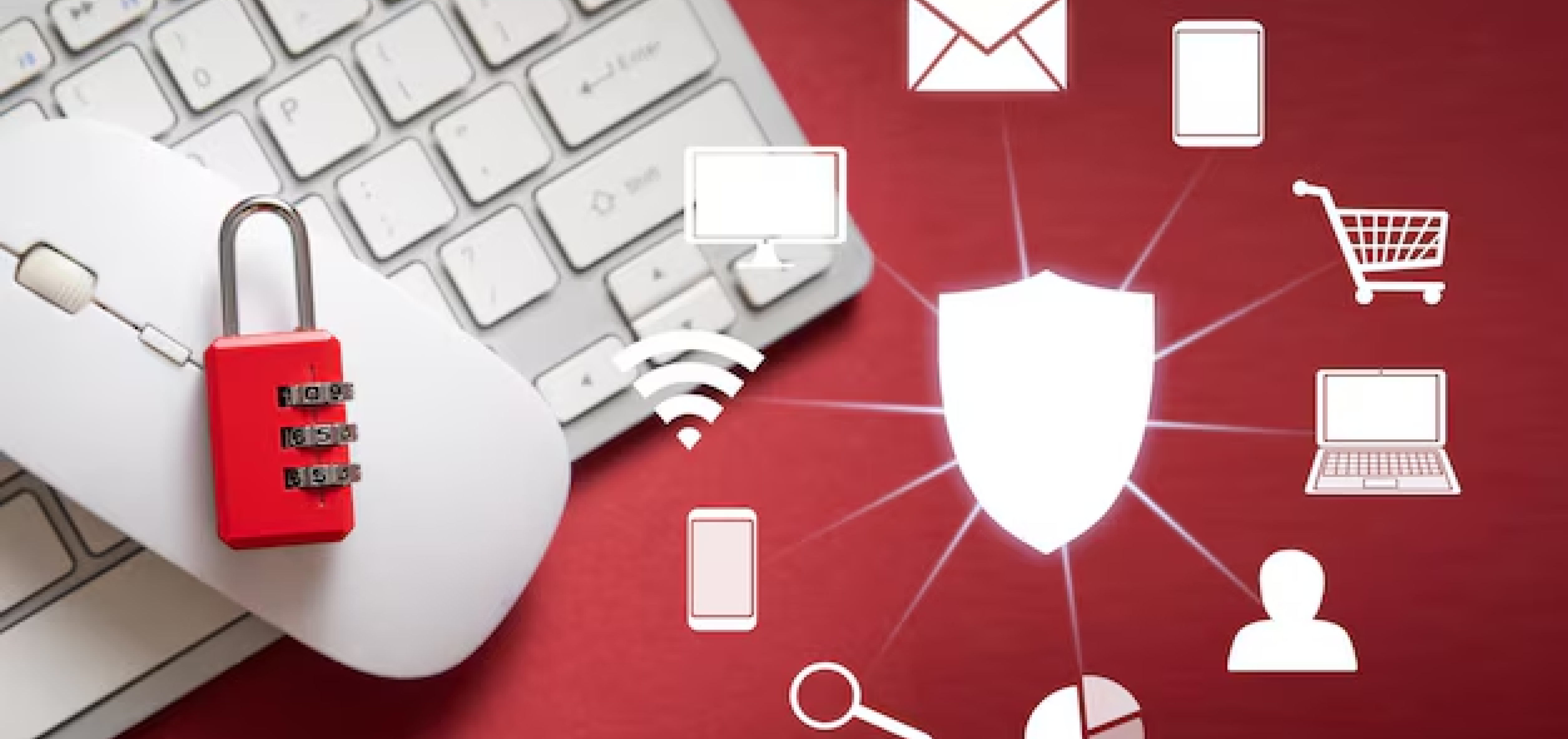
eCommerce fraud is a growing concern and you need to take protective measures to keep your online store secure. To protect your store, you can consider investing in robust security measures that help safeguard your business and instill trust in your customers.
Here I’ve listed some of the most necessary measures you can take to protect your beauty store.
- SSL certificates — SSL (Secure Sockets Layer) certificate helps encrypt data transmitted between your website and visitors. It ensures that sensitive information, such as credit card details, remains confidential. So, make sure to purchase it for your online beauty store.
- Fraud Prevention Tools — Multiple tools in the market help you protect your business from fraudulent transactions. These tools use advanced technology to analyze customer behavior, IP addresses, payment information, and device characteristics. This helps reduce the risk of financial losses and maintain a secure online shopping experience for your customers.
- Regular Data Backups — Being consistent with backups is highly necessary as cyberattacks or system failure can come up out of nowhere to disrupt your online presence. When you have data backup ready, you can recover the data loss quickly and minimize disruption to your business operations.
3. Make a Test Order
Okay, so until now we have completed all our necessary tasks, yet we can’t launch your website without doing thorough testing. So, it’s time you act as a customer and put a test order through.
This will be the process:
- Start by walking through your website just as a customer would.
- Navigate through your product categories, select an item, and add it to your cart.
- Pay close attention to every detail along the way—check that product descriptions are displaying correctly, images are loading properly, and any promotional offers are being applied as expected. This is your chance to spot anything that might look off before a real customer does.
- Once you’ve selected your product, proceed to the checkout.
- Test out the process for both guest checkouts and registered user checkouts if applicable.
- Ensure that the forms for customer information—such as name, address, and payment details—are functioning smoothly and without glitches.
- Be on the lookout for anything confusing or cumbersome that could deter a customer from completing their order.
- Next, test your payment gateway.
- Confirm that your system can process payments accurately and securely.
- Check that all accepted payment methods are functioning, from credit and debit cards to third-party options like PayPal or Apple Pay, depending on what you offer.
- After placing the test order, pay close attention to the confirmation page and any emails or messages that are sent automatically.
- Work on its fulfillment and track how shipping information flows through your system.
- Once the delivery process is clear, go through the entire return or refund process.
And that’s all. If you find any hurdles throughout the way, make sure to fix them and ensure a better shopping experience for your customers. It is absolutely necessary to conduct a thorough check of your site since you want to avoid any potential issues your customers might find.
With these tasks completed, your store is almost ready to launch. So, let’s move to the next step.
Step #12 — Get the Word Out
Your store is nearly developed and prepared, and it’s the right time to start planning for the grand opening. Here’s how to ensure your beauty eCommerce store gets the attention it deserves:
1. Prepare a Date for Launch
Start by selecting a launch date that aligns with your marketing strategy and target audience. Consider factors like seasonal trends, holidays, or industry events that might influence customer interest.
2. Learn Marketing Techniques & Set Up Social Media Accounts
To effectively reach your beauty audience, invest time in learning essential marketing techniques. You can start with understanding search engine optimization (SEO), content marketing, and social media strategies. Also, you can work on:
- Social Media Presence — On your social media profiles such as Instagram, Facebook, and TikTok, start to create engaging content, share behind-the-scenes glimpses, and interact with your followers to build a community.
- Influencer partnerships — This is where you collaborate with beauty influencers who work within the beauty niche and have a similar audience as yours. When they promote your brand launch, you can avail increased visibility and credibility.
3. Promote Your eCommerce Launch Event on Social Media.
Once you’ve worked on all areas of your social media, it’s time to initiate the buzz with your launch. Here’s how you do it.
- Prepare Social Media Posts — Prepare and share engaging content, teasers, and countdown posts to build anticipation among customers.
- Promotional Banners — Design eye-catching banners for your website and social media profiles.
- Special Offers — Attract customers with exclusive discounts, free gifts, or limited-time promotions. Consider offering early-bird discounts or loyalty rewards to encourage initial purchases.
With these steps and everything in place, it’s time for the final step!
Step #13 — Go Ahead & Launch It! 🚀

After all the preparations, it’s time to make your beauty store live for customers. Remember, launching your store is just the beginning, so you’re required to be adaptive toward making changes in accordance with customer feedback, sales data, and emerging trends in the beauty industry.
;
Congratulations on hitting this mark! You now know how to create and start a profitable eCommerce beauty store. Now, let’s learn some strategies that help create a beauty store that helps you survive better in a competitive beauty industry.
Best Practices for Building a Successful Beauty eCommerce Store
To create a successful beauty eCommerce store, you need to work more than just building an online store and making it live. Here, we will go over key tactics to set up a productive beauty selling website that can draw and retain users. Let’s get into it.
1 — Personalize Your Online Beauty Store
Personalizing your website means customizing your offerings and storefront for each customer to meet their needs and preferences. When your customers see products and recommendations that align with their interests, they become more likely to explore more of your products and feel valued.
In easy terms, when you provide personalized experiences all over your website, your customers are more likely to engage with your offerings, leading to better sales and conversions. To implement personalization:
- Understand your ideal customer — what are their interests, needs, and online behavior?
- Later, with those insights, customize your content and offer product recommendations based on individual preferences.
- Use interactive features such as quizzes, style guides, and more that allow users to understand how your product will work for them.
By incorporating personalization in your beauty store, you can provide an enjoyable shopping experience that encourages customers to explore your product offerings.
2 — Stay Ahead of eCommerce Trends.
Staying ahead of eCommerce trends is highly crucial as the beauty market is always saturated and you need to stay ahead of the competition. Some of the significant trends in modern beauty eCommerce are as follows:
- AI-powered product recommendations
- Augmented reality (AR) for virtual try-on
- Voice search optimization
- Mobile-first design
- Sustainable and eco-friendly practices
For more comprehensive knowledge, check out these current eCommerce trends.
3 — Talk About Your Social Responsibility as a Beauty Brand
Most consumers are conscious of the beauty products they use, and they want to know if it harms them and their animals or is safe for the environment. So, all you have to do is be the one.
Here are some measures you can take to gain the trust of your audience:
- Be open about discussing your manufacturing process
- Make sure your products are cruelty-free, paraben-free, and vegan to gain the trust of conscious customers.
- Use recyclable packaging materials while promoting your vision of sustainability.
By prioritizing ethical sourcing, cruelty-free practices, and eco-friendly packaging, you will be able to show your commitment to society and customers will definitely appreciate that.
4 — Provide a Greater Shopping Experience
When a customer chooses to explore your products and show interest in purchasing from you, it’s your responsibility to make it enjoyable. This is because when customers have a seamless and enjoyable time browsing your store, they are more likely to reconsider your brand for future beauty needs.
If you’re confused about ways to provide a better shopping experience, here are some suggestions:
- Provide useful information like beauty tips, trend reports, or care tutorials that help them understand your product.
- Spend on professional product photography, interesting product descriptions, and video ads.
- Make a user-friendly website with clear navigation and a quick checkout process.
- Ensure better speed and performance all over your website.
- Integrate interactive features that allow customers to discover their ideal products.
These are some of the ways you can improve the customer journey on your website. However, you can understand what works better for your customers and implement the improvements over time.
5 — Stay in Contact With Your Customers
Building and maintaining strong relationships with your customers is crucial for long-term success in the beauty eCommerce industry. Here’s how you can do it:
- Email Marketing — Build an email list and send targeted newsletters with relevant promotions and offers.
- Social Media Marketing — To build a community, respond promptly to their comments, questions, and messages. Also, occasionally, organize engaging contests and giveaways.
- Loyalty Programs — Build a reward policy that rewards customers for their repeat purchases with points, discounts, or exclusive offers.
That was all.
When you follow these strategies, you can build a profitable beauty store that drives continuous revenue.
Also, do you want to see how these strategies are implemented in reality? Well, the next section is just about that, let’s move further to explore leaders in the beauty niche and what they did best.
5 Best Beauty eCommerce Brands to Take Inspiration From
Once you have a strong basis for your beauty e-commerce shop, it’s time to review some industry-best practices. Analyzing these top companies will help you to understand and get ideas to improve your web presence. Let’s explore the top five beauty brands that define success.
1. Fenty Beauty
Here are key success factors of Fenty Beauty’s online store:
- Bold, inclusive branding is prominently featured on the homepage.
- High-quality product imagery with diverse models.
- Clear categorization of products (Makeup, Skincare, Hair, & Fragrance).
- Detailed product listing with key highlights, ingredients, how-to-use videos, and product reviews.
- “Shade Finder” tool for personalized product matching.
- Streamlined checkout to minimize steps and offer guest checkout.
- Transparent policies and clear shipping and return information.
2. Lancer Skincare
Here are the key success factors of Lancer Skincare’s online store:
- Clear categorization of products (Shop by category, concerns, and skin type).
- Detailed About Us page showcasing the history of Lancer Skincare.
- Dedicated FAQ page to address all customer queries.
- High-quality product images from multiple angles.
- Complementary product recommendations to increase average order value.
- Filtering options to narrow down products by price, skin type, etc.
- Offers auto-delivery options (annually, Every 3, 6, and 9 months).
- Detailed product descriptions.
- Referral program to incentivize word-of-mouth marketing.
- Loyalty program to encourage repeat purchases.
3. The Ordinary
Here are key success factors of The Ordinary’s online store:
- Minimalist design with plenty of white space creates a clean, uncluttered look.
- A prominent search bar and navigation menu make it easy to find products.
- Featured products and promotions draw attention to best-selling items.
- Detailed product descriptions highlight key ingredients, usage details, and benefits.
- High-quality product images allow customers to see the product clearly.
- The “See it Action” video is added for every product description.
- Filters allow customers to narrow down options based on their needs (e.g., skin type, concern).
- Clear categorization of products (Shop by ingredient, concerns).
- A dedicated product page for PM (Night) skincare. They suggest Prep, Treat, and Seal steps according to the skin concern.
- Detailed 4-minute quiz to build your personalized regimen according to your skin type and concerns.
4. Pure Daily Care
Here are key success factors of Pure Daily Care’s online store:
- Clear categorization of products (Facial Steamer, LED Devices, Oil Diffusers, and Clinical-Grade Skincare).
- Offer clear and detailed policies for returns, shipping, privacy, terms & conditions, and cookies to build trust and transparency with your customers.
- Detailed product description, including its benefits, what’s included, and how to use it.
- High-resolution images showcasing the product from multiple angles.
- A countdown timer for limited-time sales to create urgency.
5. Glossier
Here are key success factors of Glossier’s online store:
- User-friendly navigation with clear categories for skincare, makeup, balm, body, and fragrance.
- Comprehensive product descriptions, ingredient lists, and usage instructions.
- High-quality visuals showcasing products from multiple angles.
- Personalized product recommendations to encourage additional purchases.
- Well-written About page with high-quality images to show brand history.
- Help and FAQ page to resolve all customers’ queries.
These beauty e-commerce companies demonstrate effective approaches to captivate consumers, highlight products, and generate sales.
Conclusion
From finding the right niche to launching your beauty store, you’ve now seen how to build an online beauty business step by step. While this marks only the beginning of your journey, you will experience both exciting moments and challenging times along the way to success.
To overcome those challenges, you can apply creative ideas, stay updated with trends, and listen carefully to your customers’ feedback. With consistent commitment, unique strategies, and strong knowledge, your beauty eCommerce store will gradually build a powerful online presence.
All I can suggest is trust in your desires and plan accordingly.
Moreover, our eCommerce experts have 11+ years of expertise in building eCommerce websites in the beauty niche. So, if you still have any questions hanging in your head, it’s your opportunity to avail a free consultation with them and figure out your doubts.
Book your meeting without eCommerce experts here.
We are waiting to hear from you. Thank you. 🙂






Post a Comment
Got a question? Have a feedback? Please feel free to leave your ideas, opinions, and questions in the comments section of our post! ❤️